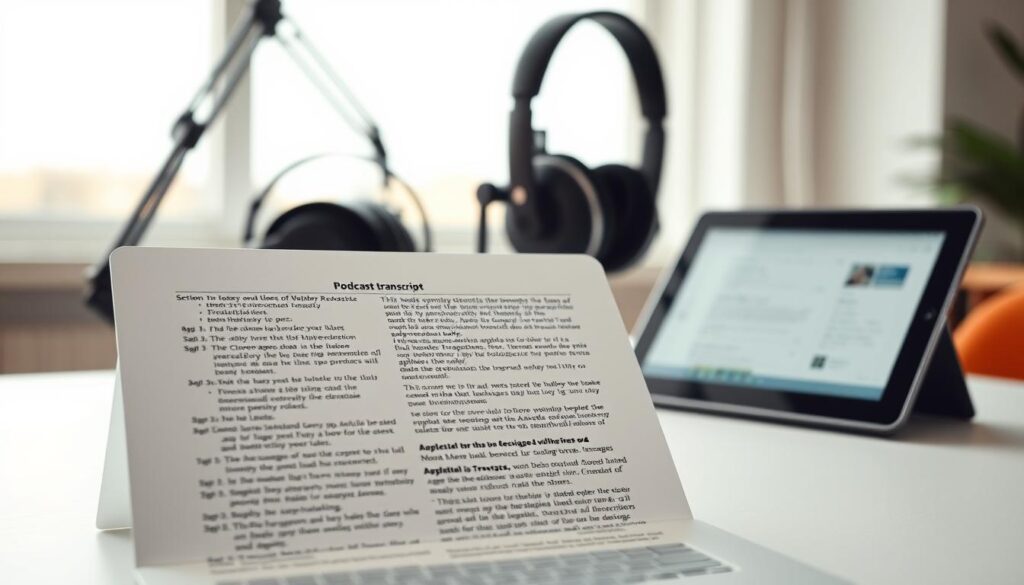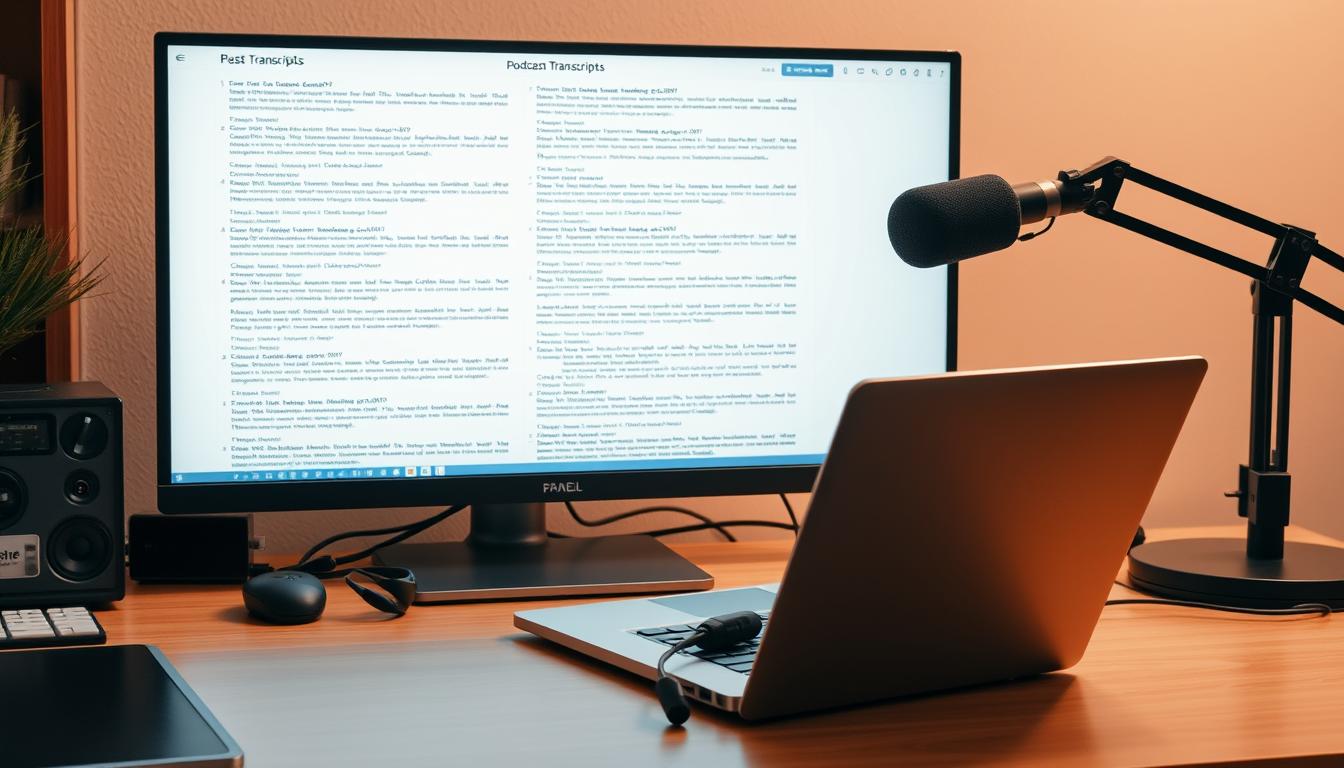As a professional SEO copywriter, I know how key podcast transcripts are. They make listening better and boost your online presence. With more people tuning into podcasts, it’s vital to offer transcripts for everyone.
Making podcast transcripts might seem hard, but it’s a must. I’ll show you how to do it, from why they’re important to how to use them on your site. We’ll also look at how they help with SEO.
Key Takeaways
- Podcast transcripts improve the listener experience and offer SEO benefits
- Transcripts cater to different learning styles and improve accessibility
- Creating podcast transcripts is a crucial step in maximizing the impact of your podcast content
- Podcast transcripts can improve search engine rankings and increase online visibility
- Implementing transcripts on your website can enhance the user experience
Understanding Podcast Transcripts and Their Value
Exploring podcasting, I see how podcast transcripts boost the listening experience. These written versions of audio or video content offer an easy way to get information. They make it more accessible and convenient for listeners.
With more people wanting written content, podcast transcripts are key in digital marketing. They play a big role in podcast accessibility.
Podcast transcripts meet different audience needs. They help those with hearing issues, non-native English speakers, and those who like reading over listening. By offering podcast transcripts, creators make their content more inclusive. This way, they reach more people, improving podcast accessibility.
- Improved podcast accessibility for people with hearing impairments
- Enhanced comprehension for non-native English speakers
- Increased flexibility for listeners who prefer to read rather than listen
By adding podcast transcripts to their strategy, creators boost podcast accessibility. They also grow their online presence and reach more listeners.
The SEO Power of Podcast Transcripts
As a podcaster, I’ve found that sharing my episodes in written form boosts my online presence. Podcast transcripts help my website get more traffic and rank better in search engines. They open up many SEO benefits, helping me reach more people.
Transcripts make it easier for search engines to find and index my content. By using the right keywords, I can improve my site’s SEO. This leads to more visitors, better engagement, and loyal listeners.
Some key SEO benefits of podcast transcripts are:
- Improved search engine rankings
- Increased website traffic
- Enhanced online visibility
- Better content indexing
Using podcast transcripts in my strategy unlocks SEO’s full potential. It helps me grow my podcast, reach more people, and build my brand. I become a trusted voice in my field.
Making Your Podcast Accessible to Everyone
As a podcaster, I aim to make my content available to all. This is why podcast accessibility is key. By offering podcast transcripts, I help hearing-impaired listeners, reach people worldwide, and support various learning styles.
Here are some ways podcast transcripts boost accessibility:
- Supporting hearing-impaired listeners by providing a written version of the podcast
- Reaching a global audience by making the podcast available in multiple languages
- Accommodating different learning styles by providing a visual representation of the podcast content
By focusing on podcast accessibility, I make my content inclusive for everyone. This benefits my listeners and grows my podcast’s reach. With podcast transcripts, I can engage a broader audience.
By enhancing podcast accessibility, I also boost my search engine rankings. Search engines like Google favor accessible content. Offering podcast transcripts helps my podcast reach more people.
Methods for Creating Podcast Transcripts
Creating podcast transcripts can be done in several ways. As a podcaster, I’ve tried different methods to find the best one. I’ll show you the various methods, their good and bad points, to help you pick the right one for your podcast.
Manual transcription is a common method. You or someone else types out the podcast episode. It’s time-consuming but very accurate. Automated software can save time but might need editing to be perfect.
Hiring professional transcription services is another option. They offer high-quality transcripts quickly but cost more. Here are some things to think about for each method:
- Manual transcription: high accuracy, time-consuming, and labor-intensive
- Automated software: fast, affordable, but may require editing
- Professional transcription services: high-quality, quick turnaround, but more expensive
The best method for you depends on your needs, budget, and resources. Think about these factors and the pros and cons of each. This way, you can pick the most effective method for creating great podcast transcripts.
Essential Tools for Podcast Transcription
Creating top-notch podcast transcripts needs the right tools. With so many options, picking the best one can be tough. You should think about accuracy, ease of use, and cost when choosing transcription tools. This section will cover the key tools for podcast transcripts, like automated software, professional services, and DIY tools.
Using transcription tools is key for quality podcast transcripts. They help make accurate and quick transcripts, boosting your podcast’s quality. Popular tools include automated software and professional services for fast, high-quality transcripts.
If you’re watching your budget, DIY tools are a good choice. They let you make your own transcripts with software or online platforms. Some top DIY tools are foot pedals and transcription software. When picking a tool, think about these:
- Accuracy: Look for tools with high accuracy, like automated software with advanced tech.
- Ease of use: Pick tools that are simple to use, like easy software or online platforms.
- Cost: Consider the tool’s price, including any subscription or one-time fees.
By considering these points and picking the right tool, you can make great podcast transcripts. Whether it’s automated software, professional services, or DIY tools, find what fits your needs and budget. With the right tools, you can make accurate and efficient transcripts that elevate your podcast.
Best Practices for Transcript Formatting
Formatting podcast transcripts is key for easy reading and accessibility. A well-formatted transcript helps listeners follow and understand the content. Here, we’ll cover the best ways to format transcripts, including structural elements, style guidelines, and time stamps.
Structural Elements
A transcript has an introduction, body, and conclusion. The introduction should give context and set the tone. The body should have sections or paragraphs with clear headings and subheadings. The conclusion should summarize the main points and offer a call to action.
Style Guidelines
Style guidelines keep the transcript consistent. Use a standard font, size, and line spacing. Proper punctuation, grammar, and spelling are also crucial. The transcript should be easy for everyone to understand, avoiding jargon and technical terms.
Some key style guidelines include:
- Write clearly and concisely
- Avoid jargon and technical terms
- Use proper punctuation, grammar, and spelling
- Stick to a standard font, size, and line spacing

Time Stamps and Speaker Attribution
Time stamps and speaker attribution are vital for podcast transcripts. Time stamps show when a segment or quote occurs. Speaker attribution makes it clear who is speaking, especially in podcasts with multiple guests.
| Element | Importance | Best Practice |
|---|---|---|
| Time Stamps | High | Use a standard format, such as HH:MM:SS |
| Speaker Attribution | High | Use a clear and concise format, such as “Speaker: Quote” |
By following these formatting best practices, you can create a high-quality podcast transcript. Use headings, subheadings, and bullet points to make your transcript engaging and easy to read.
Quality Control and Editing Tips
Creating top-notch podcast transcripts requires careful quality control and editing. These steps make sure your transcript is right, without mistakes, and keeps listeners interested. Spending time on these steps can really boost your podcast transcript’s quality.
Here are some important things to check during quality control and editing:
- Accuracy: Make sure the transcript matches the audio perfectly.
- Grammar and punctuation: Look for any grammar or punctuation errors.
- Clarity: The language should be simple and easy to get.
By focusing on these areas, you can make your podcast transcripts better. This will help your audience enjoy your podcast more.
Implementing Transcripts on Your Website
Now that you’ve made your podcast transcripts, it’s time to put them on your website. This step is key to making your content easy for everyone to see. You’ll need to think about how to make your website work well with the transcripts.
It’s important to make your transcripts easy to find and read. Use a simple design that lets users move through the text smoothly. Also, make sure your website is easy to use and that the transcripts are easy to find.
- Making sure the transcripts are accurately formatted and easy to read
- Using a consistent design and layout throughout the website
- Making sure the transcripts are easily accessible and can be found using search engines
- Using podcast transcripts as a key part of your content distribution strategy
By focusing on these points, you can make your transcripts a great resource for your audience. This can lead to more people engaging with your content. With careful planning, you can make your website more welcoming and useful for everyone.
Conclusion: Maximizing the Impact of Your Podcast Content
Podcast transcripts are a great way to make your show better for listeners. They help everyone, not just those who are hard of hearing. Plus, they can really help your SEO benefits too.
By using transcripts, you can reach more people around the world. This also helps search engines find your podcast. So, more folks can enjoy what you have to say, making your podcast more successful.
So, why not start making your own podcast transcripts today? Get the right tools and stick to a format. Keeping your transcripts up to date is key. This effort will make your podcast easy to find and listen to, reaching more people than ever before.
